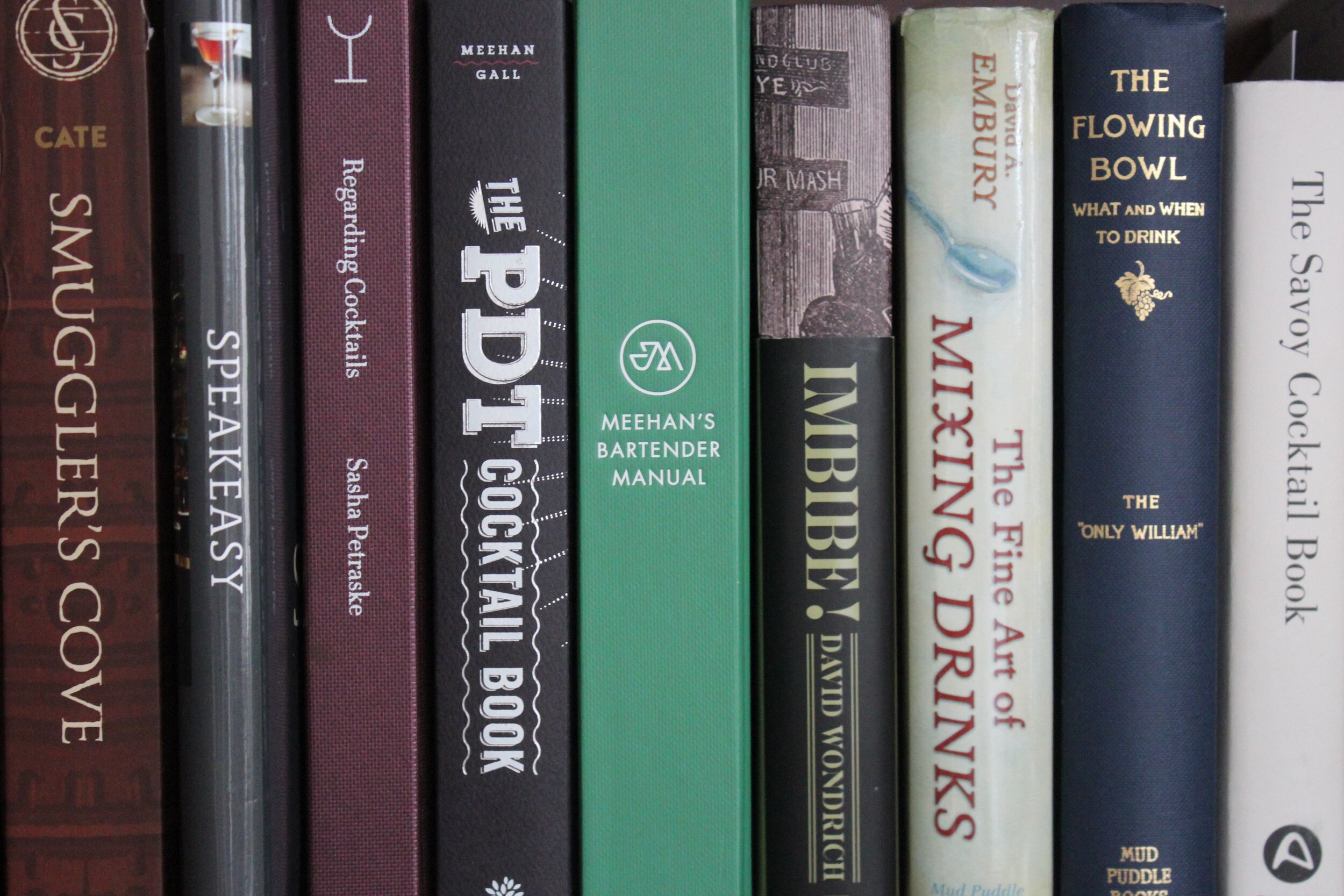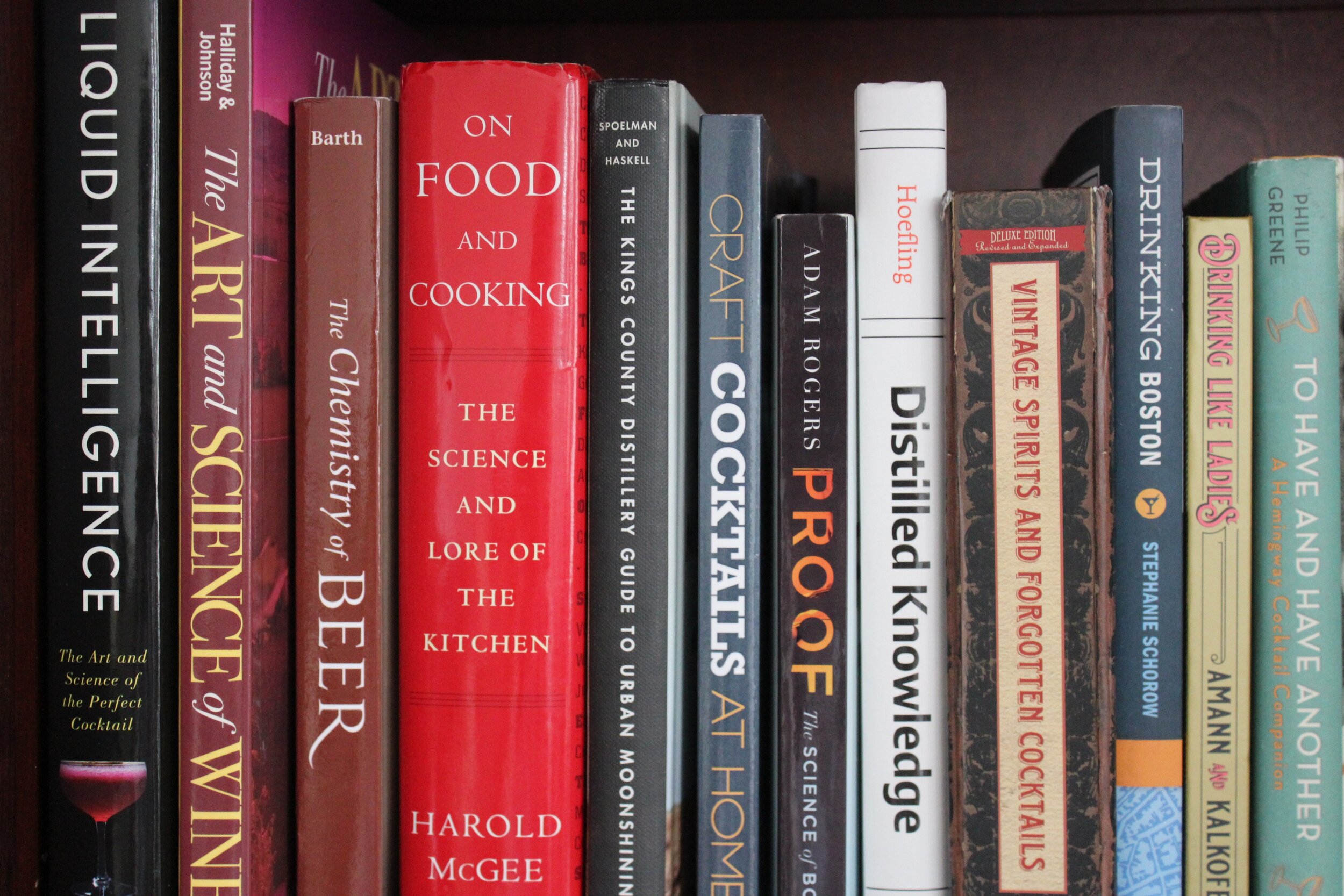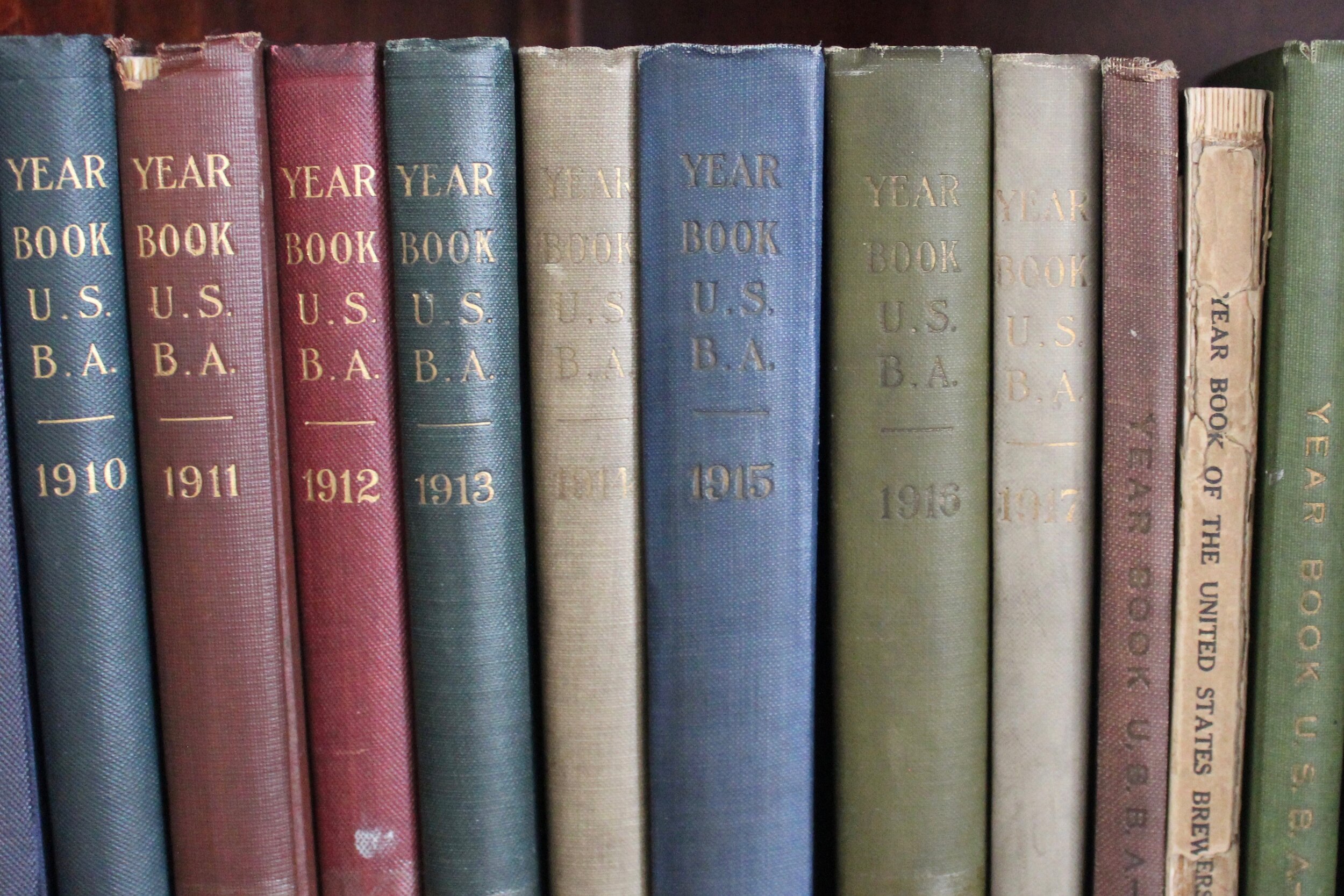Cocktail Books for the Home Bartender
Reading about cocktails can be nearly as fun as making and drinking them. Of course, you knew that already, which is why you’re on this site. If you’re just building out your home bar library and not sure where to start, here are the first five purchases I’d recommend:
Imbibe! by David Wondrich
Meehan’s Bartender’s Manual by Jim Meehan
A Proper Drink by Robert Simonson
One significant classic recipe book (e.g., The Savoy Cocktail Book by Harry Craddock, The Old Waldorf-Astoria Bar Book by Albert Stevens Crockett, The Fine Art of Mixing Drinks by David Embury, or Trader Vic’s Bartender’s Guide, if you can find a copy)
One significant contemporary recipe book (e.g., Regarding Cocktails by Sasha Petraske, compiled by Georgette Moger-Petraske; Speakeasy by Jason Kosmas and Dushan Zaric; The PDT Cocktail Book by Jim Meehan; or Smuggler's Cove by Martin and Rebecca Cate)
That set will give you a broad sweep of cocktail history, a firm grounding in theory, most of the recipes you know by name and may want to look up, and dozens more drinks you aren’t already familiar with that you can discover, explore, and adapt. That said, if you’d like more detail, read on…
A selection from my own cocktail library (I have A Proper Drink as an ebook, to my shame).
The Top Three
In addition to the many virtues of these books, I should tell you that these three authors are very, very good at balancing the recipes they write about. I’m amazed how often I end up agreeing with at least one of them when trying to find the best proportions for a given drink.
Imbibe! From Absinthe Cocktail to Whiskey Smash, a Salute in Stories and Drinks to "Professor" Jerry Thomas, Pioneer of the American Bar by David Wondrich
A guide to the mixed drinks of the nineteenth century, through the lens of the evolving definition of ‘cocktail’ and with many references to Jerry Thomas. Dave Wondrich is the preeminent historian of cocktails, and the era he describes gave us many of the drinks we still enjoy today, whether directly or as descendants of these early proto-recipes. This book provides an essential foundation in the structure and methods of drink mixing, provides scores of spot-on recipes, and benefits from many a trademark Wondrichian aside. It’s a pleasure to read as well as to mix from.
Meehan’s Bartender’s Manual by Jim Meehan
Coming off the success of The PDT Cocktail Book, Jim Meehan has produced what I think will go down as the cocktail renaissance’s magnum opus. Certainly, it comes the closest to that title of any book I’ve yet read. Exhaustively researched and comprehensive, it covers everything from the classification of spirits to the physical layout of a commercial cocktail bar. One hundred recipes are included, each given a full page (with a full-page photo opposite) to discuss the drink’s history, variations, and the reasons Meehan chooses to make it in the way that he does. There is no better insight available into the thought process of one of the revival’s leading lights, and the reader benefits enormously from his knowledge however much or little of it is applied. The book is also peppered with quotes from the author’s many interviews with significant writers, bar operators, and spirits producers, along with their photos, which makes it a sort of yearbook for the world of hospitality.
A Proper Drink: The Untold Story of How a Band of Bartenders Saved the Civilized Drinking World by Robert Simonson
The definitive history of the cocktail renaissance itself (its publication perhaps being one of the signs that we had already moved into the cocktail baroque period). Robert Simonson is a journalist with several cocktail books to his credit who has extensively covered our era’s mixological revival, and presents it in a tight, compelling narrative, based on his own experience of it and interviews with the essential players. The story is critical for anyone who appreciates modern drinking to read, in order to see how far we’ve come, how much it was driven by individual people – and how lucky we are that it happened at all. But if that’s not enough, Simonson punctuates his chapters with recipes for major contemporary classic cocktails and older drinks that have been successfully revived, charting the evolution of drink mixing across three decades and multiple continents.
More from my collection, including a few that I cited in Distilled Knowledge. (Can you tell which ones?)
Classic Recipe Books (Pick One)
The cocktail renaissance was helped along by the existence of certain touchstones of mixology. It’s very common for people who are invested in mixing drinks to take one of these books as a touchstone, regularly revisited whenever inspiration is needed. The classics get that way for a reason, after all.
Some of the most common choices, due to availability, quality, or both:
The Savoy Cocktail Book by Harry Craddock. The house cocktail guide of the American Bar at the Savoy Hotel in London, a major center of cocktailing during Prohibition and still a world-class bar today.
The Old Waldorf-Astoria Bar Book by Albert Stevens Crockett. Not as popular as the Savoy, but at least as good. Combined, these traits make it a goldmine for forgotten classics. Also includes some great observations on Prohibition in New York, written immediately after it ended.
The Fine Art of Mixing Drinks, by David Embury. The most significant postwar, pre-renaissance cocktail book - written not by a bartender, but by a lawyer, and very much for the home cocktail-maker. Also the first serious work of cocktail theory. Embury is idiosyncratic and his recipes are way too spirit-forward, but this is the book I personally come back to.
Trader Vic’s Bartender’s Guide, by Victor Jules Bergeron. I don’t have a link for this one, because it’s out of print but too recent for facsimiles; you’ll have to get one secondhand if you want it. I haven’t even read it myself, but I include it on this list for two reasons. First, this was the original compendium of tiki, way back before Jeff Berry started gathering up its history; if that’s your jam, this is the old book you want. And second, I know that Drink’s exceedingly talented Ezra Star is a fan of the book, which is enough of an endorsement for me.
You can also get the original cocktail guide, Jerry Thomas’s How to Mix Drinks, or, the Bon-Vivant’s Companion, in facsimile, but if you have Imbibe! you probably don’t need to. Other options from the nineteenth century include Harry Johnson’s Bartender’s Manual and The Flowing Bowl - What And When To Drink by William “The Only William” Schmidt. Moving into the twentieth, Cocktail Kingdom has nice reproductions of George Kappeler’s Modern American Drinks and “Cocktail” Bill Boothby’s The World’s Drinks and How to Mix Them, among others. Digital copies of many books that haven’t gotten modern editions (as well as some that have) are available through the free online library of the Exposition Universelle des Vins et Spiritueux in France, including quite a few in other languages. Recipes for Mixed Drinks by Hugo Ensslin is particularly worth a look.
Remember, half the fun of the cocktail renaissance has been (re)discovering recipes in old books that were underrated or had been forgotten through the years. Lucky for you, these books have hundreds of recipes in them. Who knows? You could find the next forgotten drink that’s ready for prime time - or at least, for regular service in your house.
As an alternative to this category, you could also pick up Ted Haigh’s Vintage Spirits and Forgotten Cocktails (or its tiki equivalent, Jeff Berry’s Beachbum Berry Remixed), but I find that those books are best used in conjunction with the classics from which they draw inspiration.
A decade of the Year Book of the United States Brewers’ Association, covering the run-up to and first years of Prohibition. Incredibly interesting books. May not be readily available in your area.
Contemporary Recipe Books (Pick One)
The other half has been developing new drinks, often using new ingredients, and then publishing cocktail guides of our own for future drinks enthusiasts to pore over.
The best of these are often the house cocktail guides of major bars, including:
Regarding Cocktails, by the late Sasha Petraske, compiled by Georgette Moger-Petraske. A posthumous collection of essays by and about Sasha Petraske, one of the defining figures of the cocktail renaissance, known for his attention to detail, insistence on propriety, and reverence for the classics. You can learn a lot about bartending and cocktails by reading those. That said, this is also a recipe book, the closest we’ll get to a house cocktail guide from Sasha’s bar Milk and Honey, “The Bar Heard ‘Round the World.” Eighty-five recipes are printed, all of them either classics or modern drinks built along classical likes (a Petraske hallmark), each accompanied by a memory of the drink, the bar, and the proprietor, as shared by someone from the Milk and Honey family.
Speakeasy: The Employees Only Guide to Classic Cocktails Reimagined, by Jason Kosmas and Dushan Zaric. The first good cocktail book I ever owned, and phenomenally influential on my personal mixological development. Includes a mixture of classics, interpolated classics, and original recipes, opposite full-page photographs, with descriptions of the authors’ process and the recipes’ histories.
The PDT Cocktail Book: The Complete Bartender's Guide from the Celebrated Speakeasy, by Jim Meehan. Three hundred recipes from the award-winning bar, presented in a short format like Mr. Boston and others have done before. The creator, first publisher, or modern adapter of a recipe receives an attribution, so you can trace Meehan’s sources; and each recipe includes a marginalium with a tidbit on history or preparation.
Smuggler's Cove: Exotic Cocktails, Rum, and the Cult of Tiki, by Martin and Rebecca Cate. A magisterial volume on the history of tiki from a leading contemporary tiki bar, featuring an invaluable system for classifying rum and scores of classic and original recipes. Full of gorgeous photography as well, and one of the best examples of the bar-book-as-coffee-table-book.
That said, there are modern recipe books not affiliated with specific bars. These may have more original or idiosyncratic recipe lists, but if you have a copy of A Proper Drink, you should already have the most important contemporary classic cocktails covered, so there’s no harm in venturing out. I happen to like:
Drinking Like Ladies, by Kitty Amann and Misty Kalkofen. A collection of recipes inspired by trailblazing women in history, developed by women in the modern hospitality industry. Each recipe is paired with a short biography and illustration of the figure who inspired it and includes some notes from its creator about her process. Kitty and Misty have also recently launched a podcast.
Drink & Tell and Drunk & Told, by Fred Yarm of Cocktail Virgin. Two books covering the cocktail renaissance in Boston specifically, each documenting hundreds of original cocktails from the city’s bars.
Minimalist Tiki, by Matt Pietrek of Cocktail Wonk. A great primer on tiki, rooted in an analysis of that canon’s classic drinks that helps the reader understand what techniques and ingredients are core to the genre and build a respectable home tiki operation without breaking the bank. Also includes nearly a hundred new recipes from world-class bars of the tiki revival.
A Note on Affiliate Links
Most of the links on this page go to Bookshop.org, an online retailer that leverages America’s network of independent bookstores to deliver books to your door. It’s the convenience of shopping with a larger company, but you get to support your local bookseller instead. (Read more here!) I’m an enthusiastic supporter of this mission. I’m also an affiliate marketer, which means I may make some money if you click one of those links and make a purchase. That doesn’t affect how much you pay for the books – or the choices I’ve made about which ones to recommend – but it does help me keep the lights on.
For convenience’s sake, I’ve also set up a ‘storefront’ on Bookshop, where you can see lists of the books I recommend (in the above categories and others) that are available on that platform. You’ll find it at www.bookshop.org/shop/herzogcocktailschool.


